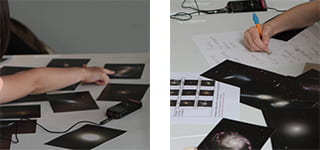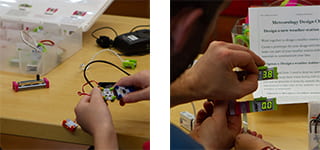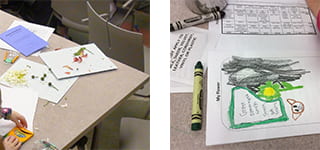STEM Pillars Curricula
Below you will find seven STEM Pillars family workshop curricula designed for use in rural libraries and museums. The audience for each workshop is families with at least one child aged 6-10. Each workshop uses project-based learning teaching strategies and family discussion prompts to facilitate learning. Because the STEM Pillars workshop curricula were written to be facilitated by scientists and engineers, teaching strategies are included. The workshop curricula presume the facilitator has STEM content knowledge specific to the STEM topic, but has not necessarily taught workshops for families before.
My Happy Valley Sky

Download: Galaxies in Our Universe
Families work together to understand that astronomers study galaxies through observation and classification. Participants observe and share descriptions of galaxy images to classify galaxies. This workshop is for children and adults working together. The curriculum is written to be facilitated by professional and amateur astronomers in your community. This workshop includes the use of NASA images with optional access to the
Galaxy Zoo citizen science page.
Becoming an Astroengineer!

Download: Collecting Data with a Lunar Rover
Families design a lunar rover to help collect scientific data on a simulated surface of the moon. Using making tools to create rovers, families explore the use of different sensors and their functionality. The curriculum is written to be facilitated by astronomers and engineers in your community. It requires the use of the littleBits prototyping tool.
Engineering My World

Download: Engineering My World
Families work together to solve engineering problems. Using an engineering design model, families design a biomedical invention for a family member who is in the hospital. The curriculum is written to be facilitated by engineers and technicians in your community. It requires the use of the littleBits prototyping tool.
Weather Where I Am

Download: Weather Where I Am
Families design a weather station that collects weather-related data to help farmers, ranchers, or gardeners. By engineering weather stations, families explore the use of different sensors and their functionality to decide how to collect data to help in decision-making. The curriculum is written to be facilitated by meteorologists or climate scientists in your community. It requires the use of the littleBits prototyping tool.
Plants Around Us

Download: Plants Around Us
Families dissect two flowers to learn about the components of a flower, and then they design a flower to attract a pollinator of their choice in order to learn about the pollination process. The curriculum is written to be facilitated by botanists, plant ecologists, farmers and extension agents in the community. It requires access to plants and plastic dissecting tools.
Pollinators Around Us

Download: Pollinators Around Us
Families discover that pollinators have diverse traits and unique behaviors through observing bumble bees in a colony. Families also examine preserved pollinator specimen’s physical traits. This curriculum is written to by facilitated by entomologists, horticulturists, life scientists, and extension agents in the community. This curriculum assumes that you are a competent bee handler who can transport and secure bees and prioritize both the safety of the bees and the participating families. The workshop requires access to bumble bees, preserved specimens, and magnifying lenses.
Water Quality in My Community

Download: Water Quality in My Community
Families work together to create three models of their community (undeveloped, developed and green built). Then they conduct an experiment to make observations about runoff water and its effects on groundwater. The curriculum is written to be facilitated by county conservation district staff members as well as water scientists, hydrogeologists, and water conservationists in your community. The curriculum uses everyday materials found in grocery or general merchandise stores (such as Walmart, Kmart, Target, and Dollar Tree). It was adapted from the middle school curriculum
Rain to Drain, Slow the Flow by Penn State Extension.















